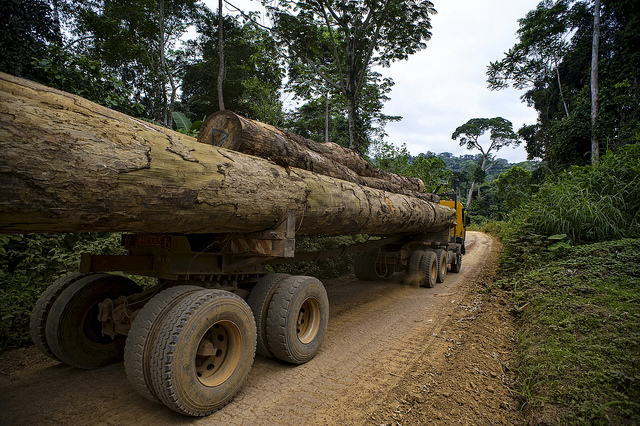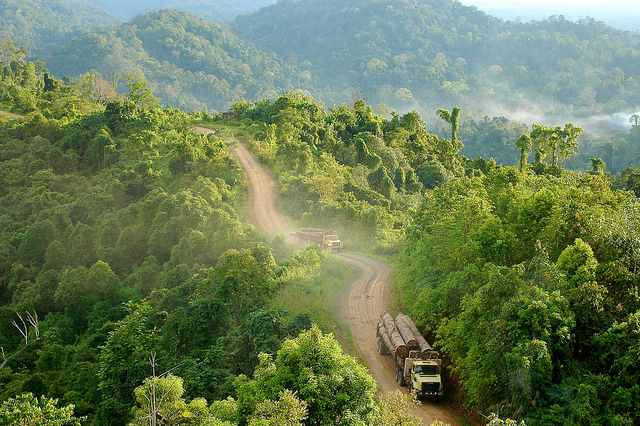By Cecilia Schubert, CCAFS
Increased accessibility through safe and solid infrastructure is needed for a country to progress on the development ladder and reduce poverty. Without it, export and import activities are severely hampered and people’s mobility and accessibility limited.
However, an expanding road network can have damaging effects on natural resources, such as biodiversity and forest cover and density. This is shown by multiple research studies from Thailand, Mexico, and Brazil. When infrastructure development reaches previously inaccessible areas, deforestation is often a consequence. Balancing trade-offs between economic development and protecting the environment requires a thorough understanding of the forces at play and their impact.

A recently released article, Impacts of Road Expansion on Deforestation and Biological Carbon Loss in the Democratic Republic of Congo, suggests that the Democratic Republic of Congo (DRC) will face a similar situation. The country has 125 million hectares of tropical forest - the second largest in the world after the Amazon - and the authors conclude that up to 2% of it could be lost, which would result in a loss estimated at 316 teragrams of carbon (TgC) as it creates 8,500 km paved roads, and new railways. Another effect will be agriculture expansion, as more land will now be deemed viable for farming.
This development is especially alarming, as the DRC has experienced much lower deforestation rates than other countries: 0.2% per year compared to, for example, estimates that range from 24.1 Mha or 1.1% per year in Indonesia.
“Our research stresses the importance of careful planning. We outline the damaging consequences that current road expansion plans could have without the proper safeguards for the forest and we want to ensure that, as policymakers chart their path toward economic development, they are aware of the potential trade-offs,” said co-author Alessandro De Pinto, senior researcher at the International Food Policy Research Institute (IFPRI).
To study the implications of an expanding road network the authors were able to construct a land-use model that compiles the scarce data available for the country. The model is also capable of representing broad land covers such as cropland, forests, and rangelands, as well as changes in area allocated to the country’s relevant crops. (Previous models treated agriculture as a single land use category.) The emphasis on changing crop patterns is not trivial given the focus on greenhouse gas (GHG) emissions from agriculture and the role that agricultural intensification can play in development.
“The land-use model that we developed for this particular study can be used as an important tool for decision-makers who want to plan for economic growth and development while taking into account the effects these plans might have on the surrounding environment,” De Pinto said.
A positive turn for agriculture intensification
An interesting finding of the article is the role that agricultural intensification can play vis-á-vis deforestation. Given some simplifying assumptions, required by lack of data, the authors come to the conclusion that agricultural production is a potent driver of deforestation. Estimates show that up to 75% of global deforestation is driven by agriculture expansion.

However, GHG emissions from intensified crop production cause little damage compared to deforestation even when the recommended high rates of nitrogen fertilizers are employed. The damage caused by farming one additional hectare of land is equivalent to the damage of losing one ha of forest after 529 years of continuous production.
“Our study indicates that agricultural intensification could play an important role in achieving sustainable development as it, coupled with the right policies to protect environmental services and forests, can help prevent further deforestation. We need more resources set aside for research to better understand how intensification can be done in a sustainable way and how the agriculture-forest interface can be better managed,” said De Pinto.
Agricultural intensification plans could also be complement efforts to reduce overall GHG emissions in the DRC in order to implement plans successfully and in accordance with the Reducing Emissions from Deforestation and Degradation (REDD+) program, the study suggests.
This project was conducted under the CGIAR Research Program on Climate Change, Agriculture and Food Security (CCAFS).
Download the article: Man, Li, Alessandro De Pinto, John Ulimwengu, Liangzhi You, Richard D. Robertson, 2014. Impacts of Road Expansion on Deforestation and Biological Carbon Loss in the Democratic Republic of Congo. Environmental Resource Economics.
About the author: Cecilia Schubert works as a Communications Officer at the CGIAR Research Program on Climate Change, Agriculture and Food Security (CCAFS), focusing on policy analysis.

I pay a visit everyday some web pages and websites to read content,
but this blog provides quality based posts.
I can't beleive I've been going for years without knowing that.